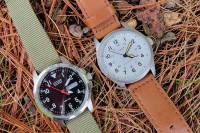Casio vs. Timex: Cheap Watch Torture Test Showdown
We pitted two titans of the timepiece market in a head-to-head battle royale to see just how much abuse these sub-$35 tickers can take.
The Timex T497139J Camper ($33) and Casio FT500WC-3BV Forester ($25) aren’t pretty watches. Their plastic cases, Velcro straps, and simple layouts don’t exactly scream “rugged” or “all-terrain endurance” like a Victorinox or G-Shock.
And yet, both of these timepieces have something of a cult following. The Forester, which I’ve seen worn unironically by both outdoors enthusiasts and construction workers alike, is considered to be something of a sleeper among connoisseurs of ugly wrist candy.
This, along my passion for beating the snot out of budget gear, got me thinking: Just how much abuse could these two hiking-themed watches take? I endeavored to find out, over several days in the woods and trails of northern Wisconsin.
Cheap Watch Torture Test

Specs and Features
The Casio is the larger of the two, with a width of 43.9 mm. But because of its relatively small face, it reads almost identically to the Timex’s 38mm dial. The Forester is also a bit taller, rising 12.6 mm from the wrist versus the Camper’s 10.55 mm.
Both come with Velcro bands affixed to their 20mm lugs, mated to resin cases and mineral crystals. Water resistance is good for 100 m across the board, with multiyear batteries and quartz movements.

Each watch comes with a button-activated LED light. The Timex’s crown pulls double duty as the activation point for its Indiglo, while Casio opted for a large, separate button at the 3 o’clock position.
Once lit, there are some subtle differences in function. The Forester’s orange LED remains on for 3 seconds before fading out, while the Camper lights up the dial itself. Timex also included luminous compound on the hour and minute hands, so you can get a general idea of the time without pressing the button at all.
All told, these watches are quite similar in terms of materials, build, and function. But we’re not here for a simple comparison. Just hours after the pair landed in my mailbox, it was time to depart for the woods.
Fit
The first day started with a 6-mile hike. I strapped a watch to each wrist and set off down the trail. This was more of a feeling-out process, to help me get an idea of which had the more comfortable ride.
Surprisingly, the results were more or less a wash. Both watches were perfectly civil hiking companions, though the band on the Timex is definitely shorter. If you have larger forearms, there may not be enough canvas to give you an adequate fit.
Verdict: Tie (Casio better for larger wrists)
Water-Resistance
Things got more serious once I made camp. The watches and I had been slathered in bug spray and sunscreen, so a rinse was definitely needed.
Once I’d conducted a little pre-wash (so as to keep those chemicals out of the lake), into the water we went.

This wasn’t a simple dunk, however. I swirled these watches through the waves and stepped on them with my full weight, driving them down into the sand. At some point (and I didn’t realize this until later), the crown on the Timex popped into the date-set position, and all the movement spun its wheel two weeks ahead.
Normally, this poses an increased risk of water entering the case. But somehow, the Camper’s integrity held.
Verdict: Tie
Flame-Resistance
Then it was back to the tent for my favorite part of any trip — the fire. And while some folks like to roast marshmallows or hot dogs over the flames, I had a slightly different idea.

That’s right. I let the pair dry off for around 2 minutes, to the point where the metal case-backs were noticeably hot to the touch.
But after allowing them to cool, I was shocked to find not a single trace of melt or discoloration on the case and crystals.
Verdict: Tie
Impact
The next day, it was time for another hike. Only this time, the watches rode somewhere other than my wrists.
I strapped each to the bottom of a trekking pole, with their glass facing down toward the trail. The purpose of this (beyond making me look like a crazy person) was to test the shock resistance of the movement and the durability of their materials.
And after several miles of rocks, mud, dirt, and roots, both emerged with their fair share of battle scars.

But you know what? Despite my best efforts to bring them down, the Forester and Camper were still ticking by the time we reached the end.
Verdict: Tie
Final Thoughts
So, what did I learn from this exercise? From my previous testing with the brand, I was fairly sure the Casio would survive. They’re the budget king for a reason, and their non-G-Shock timepieces have proven to be incredibly reliable.
What I didn’t expect was for the Camper to compete with the Forester, neck and neck. The last time these two competitors squared off, the Timex option failed rather miserably in my depraved testing.
But the Camper, with its slightly more compact packaging and impressive night light, proved to be every bit as rugged as the Casio. Its band is a bit shorter, the price is a little higher, and the movement has a much more audible tick, but the clean face and classic shape have a charm all their own.
In conclusion, either of these would make a fantastic camping watch. If you’re looking for a reasonably priced, watertight, twilight-ready timepiece with an offbeat/outdoors theme, both the Camper and the Forester would make a rock-solid addition to your collection.
Check Camper’s Price at AmazonCheck Forester’s Price at Amazon
The post Casio vs. Timex: Cheap Watch Torture Test Showdown appeared first on GearJunkie.

